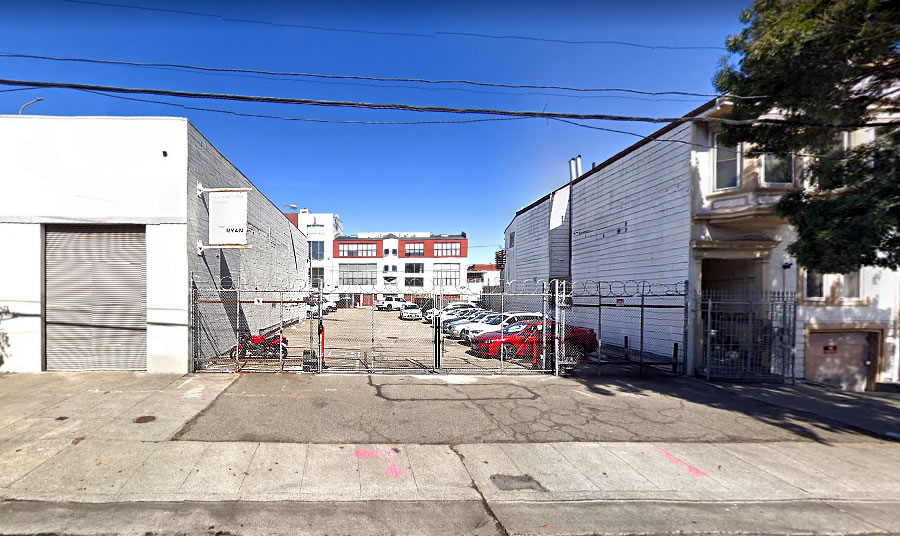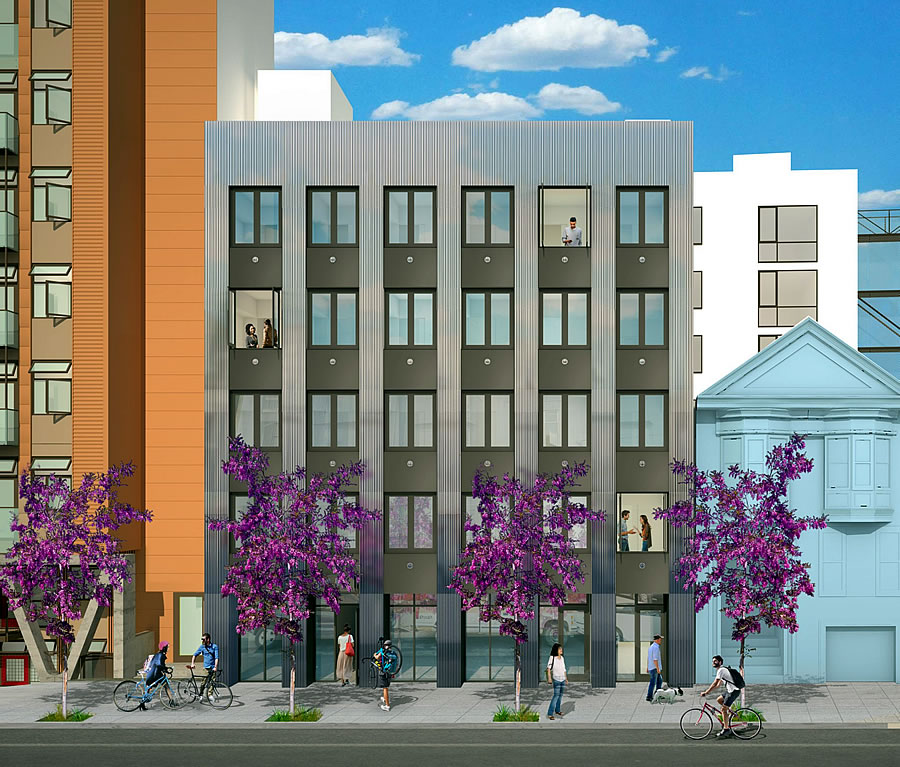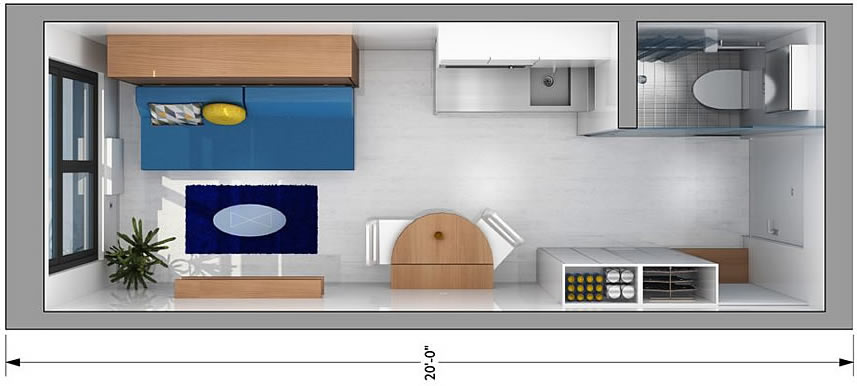With 200 mini apartments rising on the 333 12th Street parcel to the left, and the ground having been broken for 136 units to rise on the 1532 Harrison Street parcel, on the other side of the 1907-era duplex, to the right, plans to infill the Western SoMa parking lot parcel for 22 cars at 351 12th Street (aka 345 12th Street) are in the works as well.
While zoned for development up to 55 feet in height, as rendered above, Panoramic Interests is planning to leverage the State’s density bonus program to add a sixth story to the development which would then rise to a height of 66 feet.
And as envisioned, the “Folsom Flats” project would consist of 50 units of “group housing” which would average 178 square feet apiece.
The residents of the building would also share a total of 1,383 square feet of common space, including a 490-square-foot community room with a shared kitchen on the building’s ground floor; 1,435 square feet of open space, including a 735-square-foot deck on the roof; and a shed for 19 bikes in the building’s rear yard.
And per the terms of the State’s density bonus program, three (3) of the units would be offered at below market rates (BMR) to individuals making no more than 50 percent of the Area Median Income (AMI).



50 “apartments” and 19 bike storage spaces? Ridiculous.
And this isn’t even a “dorm room”; my dorm rooms in college were bigger than this.
I guess if near homeless this is a dream. However, give it a few years and this will probably be another hell hole neighborhood.
Supposedly the site next door, with standard sized units, is pre-leased to Golden Gate University and SFAI (for students). I wonder if this developer is hoping to ink a deal with another university so this will be a literal dormitory.
[Editor’s Note: As we first reported at the time, Conversion of SoMa Development into Student Housing Proposed]
CCA is going to be expanding. This building or another, I’m sure they are looking into something in Soma very similar to this.
[Editor’s Note: Plans for a 600-Bed [CCA] Dorm Earn a Qualified Thumbs Up]
Sure, but this is 10x better than tent cities.
So, wait a minute. Building these units will somehow automagically remove the existing tent cities? Are the existing and near-future residents of the existing tent cities going to be able to afford to move into these units (assuming they aren’t already earmarked for students) and so the tent cities will disappear once these units are built? Because they are 10x better? Do tell.
These buildings will help the affordability crisis for many – so they are great because of that – but no – they will do little to alleviate the tent cities. Most of the people living in the tent cities have serious issues that prevent them from inside. From full on raging schizophrenia to addiction problems so serious they result in death from overdose. They need institutions – not affordable housing.
19 bike spaces – 50 Units – SRSLY?
SF Planning needs to amend the Zoning code across the board to require 1 for 1 bike parking in all buildings that have no auto parking.
All of these housing solutions (“approaches” is perhaps more appropriate?) aren’t new and in no way automagically degrade into slums or hell holes once settled. The SROs in and around the TL only get the way they are when insufficiently cared for and maintained. Regardless, this type of housing works really well in other cities/countries and will only become more and more prevalent as space becomes less and less ample. I agree that “dorms” aren’t an ideal solution to housing shortages, but America really needs to get over its lust for exorbitant amounts of space if we want to address costs of living, etc.
AMEN
AMEN I SECOND THAT AMEN!
Thank you!
well put!
But are the homeless and “near homeless” – whatever that means – the target demographic? The only thing I see about rents is that three – count em: three of fifty! – will be BMR…which @ 50% of AMI is probably about 10 x HMI (Homeless Median Income).
Damn handsome building though, less is more in this case.
In the era of Ford Go Bike and Jump Bike, which give you similar mobility, but without the “bike getting stolen” headaches, 19 might actually be appropriate. A better coup would be for the complex to provide free “Ford Go Bike” membership which might further discourage car usage.
Exactly, that’s the point (re: people’s comments about “near homeless”) – the target group here is presumably early-20s post-collegiate types. And for them, this is a claustrophobic step down from anything they would have experienced previously. And *that*, in turn, can indeed often lead to a “race to the bottom” as the landlord chases tenants and lowers rents. That is *precisely* what happened in the Tenderloin between WWII and the 1960s, and the TL hasn’t recovered to this day.
sorry, that was meant to follow Notcom’s comment above.
As for the bikes – those day rentals are no replacement for having your own bike, if bikes are you only mode of transportation. And the “bike getting stolen” headache is obviously greatly reduced if the tenants have a secure place to store their bikes…
San Francisco’s economy today has zero similarities to the city’s economy in the 1960s.
These will hold value, but rents will increase more slowly than in other buildings.
OK grumpypants, what’s your “suggestion” ?
still way too short for this location. the western SOMA plan needs to be revisited
More building for a demographic that will grow out of it…and likely not a following demographic that is “responsible” ….the result will be a hell hole development in 15 years.
The question of whether these will become the dreaded hellhole is, of course, the asking rents.
Even if these don’t rent out to capacity, they can be used as short term rentals or converted to co-living space or pseudo hotel space.
I’m in favor of lots of small units, but I agree with other commenters that this will likely be too small for the 20-something young professional’s tastes. This is not a reasonable sized apartment you’d ever want to bring a significant other home to. Something closer to 300 square feet is far more reasonable.
As SF goes in one direction, Seattle has gone in the other. Seattle was the birthplace of the modern micro-unit movement. Back in the first years of the century. Since then there has been pushback for many reasons. One being the negative impact these developments have on the neighborhood – or have had in Seattle.A fairly recent planning determination means that Small Efficiency Dwelling Units (SEDU’s) in Seattle will no longer be meaningfully smaller than a typical studio apartment. 300 square feet. A few residents loved the micro-units but neighbors did not and a controversy brewed for a number of years over them culminating in the revised SEDU rules..
IMO, the proposed 178 square foot units are too small and, if SF pursues this “solution” to the housing crisis, I’d expect in a few years it will discover as has Seattle that it has too many negatives.
I was all prepared to say that commenters arguing these units are too small are just anti-cheap housing haters (e.g. HOW SEATTLE KILLED MICRO-HOUSING, AGAIN), but is the interior wall of the bathroom just a frosted glass panel? That would not pass the pooping-when-you-have-a-guest test, which I believe is is a minimum threshold.
As someone who owns properties in Seattle I’ve been following this story closely for a number of years. While some individuals liked living in the units, many did not.
The pro-micro-housing faction (developers loved them) touted these individuals. The pushback grew for a number of years and came from residents living near micro-unit developments. High on the list of objections were issues around the deterioration of the immediate areas around the developments.
Objectors are not “anti cheap housing”, they are anti sub quality housing – in addition to recognizing the negative impacts these developments can have on the neighborhood.
“the negative impacts these developments can have on the neighborhood”
Pray tell: is this a quantitative issue – just too many people – or a qualitative one – not the “right kind” of people?
Good luck keeping that bathroom clean or ventilated.
I stayed in an AirBnB in Toronto that was a micro-unit about this size. The real problem for long-term living is that there is nowhere to put your clothes! Sure, you can eat out, spend long hours at work, and spend your free time out and about. But you better like doing laundry because you won’t have closet room for more than 3-4 outfits.
The guy at the top right window looks like he’s contemplating jumping.
I like to think of it more as a Stanley Kowalski moment: is it to much to imagine that the woman at the curb – appropriately garbed in white – is named “Stella”??
This is purposeful construction of a hell hole ghetto, not the answer to the housing crisis. These units will engender claustrophobia and crime in the people warehoused there.
I wonder what the tipping point is for the rule of “smaller units = greater return per square foot”? It seems like this project will be pushing that limit.
I live in a victorian that is really close to these, and I will be selling my house just when they’re all finished and shiny, and before they age poorly like all the lofts from the 90’s did.